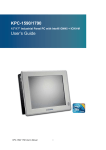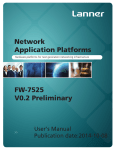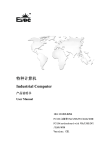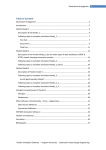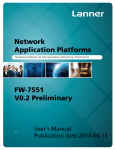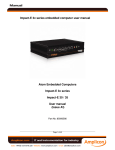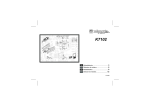Download User Manual
Transcript
Embedded & Industrial Computing Hardware Platforms for Embedded and Industrial Computing LEC-7110 Preliminary >> User's Manual Publication date:2012-11-09 TTaTTable of Contentsbeable of Conten Chapter 1: Introduction 4 System Specification . . . . . . . . . . . . . . . . . . . . . . . . . . . . . . . . . . . . . . . . . . . . 4 Package Contents . . . . . . . . . . . . . . . . . . . . . . . . . . . . . . . . . . . . . . . . . . . . . . 5 Chapter 2: System Components 6 System Drawing . . . . . . . . . . . . . . . . . . . . . . . . . . . . . . . . . . . . . . . . . . . . . . . 6 Block Diagram . . . . . . . . . . . . . . . . . . . . . . . . . . . . . . . . . . . . . . . . . . . . . . . . 7 Front Components . . . . . . . . . . . . . . . . . . . . . . . . . . . . . . . . . . . . . . . . . . . . . 8 Rear Components . . . . . . . . . . . . . . . . . . . . . . . . . . . . . . . . . . . . . . . . . . . . . . 9 Chapter 3: Board Layout 11 External Connectors . . . . . . . . . . . . . . . . . . . . . . . . . . . . . . . . . . . . . . . . . . . 11 Internal Connectors and Jumpers . . . . . . . . . . . . . . . . . . . . . . . . . . . . . . . . . . . 12 Connectors and Jumpers List . . . . . . . . . . . . . . . . . . . . . . . . . . . . . . . . . . . . . 13 Jumper Settings . . . . . . . . . . . . . . . . . . . . . . . . . . . . . . . . . . . . . . . . . . . . . . 14 Chapter 4: Hardware Setup 17 Preparing the Hardware Installation . . . . . . . . . . . . . . . . . . . . . . . . . . . . . . . . . 17 Installing the System Memory . . . . . . . . . . . . . . . . . . . . . . . . . . . . . . . . . . . . . 17 Installing the Hard Disk . . . . . . . . . . . . . . . . . . . . . . . . . . . . . . . . . . . . . . . . . 17 Installing the 3G SIM Card . . . . . . . . . . . . . . . . . . . . . . . . . . . . . . . . . . . . . . . . 18 Installing the Wireless 3G module . . . . . . . . . . . . . . . . . . . . . . . . . . . . . . . . . . 18 Wall Mounting . . . . . . . . . . . . . . . . . . . . . . . . . . . . . . . . . . . . . . . . . . . . . . . 18 Appendix A: Programming Watchdog Timer 19 Appendix B: Digital Input/Output 21 Appendix C: Terms and Conditions 22 Warranty Policy . . . . . . . . . . . . . . . . . . . . . . . . . . . . . . . . . . . . . . . . . . . 22 RMA Service . . . . . . . . . . . . . . . . . . . . . . . . . . . . . . . . . . . . . . . . . . . . . 22 2 About About Overview Acknowledgement Icon Descriptions The icons are used in the manual to serve as an indication of interest topics or important messages. Below is a description of these icons: NOTE: This check mark indicates that there is a note of interest and is something that you should pay special attention to while using the product. WARNING: This exclamation point indicates that there is a caution or warning and it is something that could damage your property or product. Intel, Pentium and Celeron are registered trademarks of Intel Corp. Microsoft Windows and MS-DOS are registered trademarks of Microsoft Corp. All other product names or trademarks are properties of their respective owners. Compliances and Certification CE Certification This product has passed the CE test for environmental specifications. Test conditions for passing included the equipment being operated within an industrial enclosure. In order to protect the product from being damaged by ESD (Electrostatic Discharge) and EMI leakage, we strongly recommend the use of CE-compliant industrial enclosure products. FCC Class A Certification Online Resources The listed websites are links to the on-line product information and technical support. Resource Website Lanner http://www.lannerinc.com Product Resources http://assist.lannerinc.com RMA This equipment has been tested and found to comply with the limits for a Class A digital device, pursuant to Part 15 of the FCC Rules. These limits are designed to provide reasonable protection against harmful interference when the equipment is operated in a commercial environment. This equipment generates, uses and can radiate radio frequency energy and, if not installed and used in accordance with the instruction manual, may cause harmful interference to radio communications. Operation of this equipment in a residential area is likely to cause harmful interference in which case the user will be required to correct the interference at his own expense. http://eRMA.lannerinc.com Copyright and Trademarks This document is copyrighted, © 2012. All rights are reserved. The original manufacturer reserves the right to make improvements to the products described in this manual at any time without notice. No part of this manual may be reproduced, copied, translated or transmitted in any form or by any means without the prior written permission of the original manufacturer. Information provided in this manual is intended to be accurate and reliable. However, the original manufacturer assumes no responsibility for its use, nor for any infringements upon the rights of third parties that may result from such use. Embedded and Industrial Computing 3 Chapter 1 Chapter 1: Introduction Thank you for choosing the LEC-7110. The LEC-7110 is Lanner’s flagship IPC. It features the Dual Core Intel® Atom™ D2550 processor. Introduction System Specification LEC 7 Series Dimension (WxHxD) 268x44x174mm (10.55”x1.73”x6.85”) Processor Intel Atom D2550 1.86GHz The LEC-7110 is an ideal solution for digital signage and infortainment or self-service kiosk whether it is carried on the public transportation or situated in a public setting . Chipset System Memory This all-in-one system is fanless and has a dust-proof case. It can be easily installed at places where space is limited and the weather condition is harsh (268x174x44mm). Storage The system can be conveniently situated in a place where space is limited and the weather condition is diverse (operating temperature -10 to +55C [with Industrial components] and -5 to +45oC [with commercial components]). which supports VGA (up to 1920x1200) and HDMI with integrated audio and video function (1920 x1200) IO •• COM x 2 (1 is in DB-9 port and the other one is a pin header; both of them are RS-232 compatible.) •• Digital Input/Output (through 2 x 5-pin terminal block) •• Audio input and output connectors (Realtek ALC886 DB9 x1 for RS232 x1; Pin header for RS232x1 GPS USB 2.0 Power Input Expansion card reader that can support 3G Internet) the front, and 2 internal pin header) Serial I/O Digital I/O •• One Mini-PCIe expansion slots (it comes with a SIM •• USB x 6 (2 external ports on the back, 2 external ports on RCA x2 for Line-out and Mic-in Display Ethernet controller) connection). It provides storage for photos, videos and other multi- media contents. Audio SATA LAN •• Dual 10/100/1000 Mbps LAN (provided by Intel 82583 •• Two SATA 2.0 Ports (SATA1 supports SATA DOM Video Grabber Intel NM10 DDR3 SODIMM x1 Up to 4GB None 2.5” HDD/SSD drive bay x1, SATA Port for SATA DOMx1 Intel 82583 x2 Intel GMA3150 Realtek ALC886 GbE RJ45 x2 DB15 x1 for VGA (1920x1200) HDMI x1 (1920x1200) No Technology Max. Capacity IDE Ethernet Controller Graphic Controller Audio Controller The list shows the versatile connectivity that the device provides: •• Intel integrated Graphics Media Accelerator 3150 LEC-7110 Others Power Input AC Adapter Hardware Monitor OS Support Certifications Compliance Operating Temperature Range with Commercial Components No 2 x 5-pin terminal block for DI x4 and DO x4 (5V TTL) Type A x4; Internal x2 DC jack with lock Mini-PCIe x1 with External SIM card reader External: Power-on button, 1x SMA antenna hole, reset. Internal: PS/2 keyboard and mouse +12Vdc +/- 5%, ATX mode 60W +12V @ 5A Fintek F81865 integrated watchdog timer 1~255 level Linux , XPE/WES2009, XP PRO FES, WS7E, WS7P, WIN 7 PRO-E CE, FCC Class A No -10 to +55C (with Industrial) -5 to +45C (with commercial) codec) Embedded and Industrial Computing 4 Chapter 1 Introduction Package Contents Your package contains the following items: •• The LEC-7110 Embedded System •• DC+12V 60W Power Adapter •• Serial-ATA/Power Cable •• Wall-Mounting Kit •• Drivers and User’s Manual CD Embedded and Industrial Computing 5 Chapter 2 System Components Chapter 2: System Components System Drawing Mechanical dimensions of the LEC-7110 174 Unit: mm 44 268 Embedded and Industrial Computing 6 Chapter 2 System Components Block Diagram The block diagram depicts the relationships among the interfaces and modules on the motherboard.. LEK-HDA1 LEB-7110 LEB-7110 VGA Up to 1920x 1200 Intel D2550 (BGA) HDMI 1x 2.5" HDD/SSD SATA Connector DDR3 800/1067 1x SO-DIMM up to 4GB Processor SATA 2x PCIe 2x SATA Connectors 1x SATA DOM GbE Controller 2x Intel 82583 LAN 1 RJ-45 LAN 2 Mini PCIe with SIM card Reader 1x Socket USB 2.0 2x Port-A in front 2x Port-A in rear 2x Pin Header PCIe USB PCH USB SPI Flash BIOS RJ-45 (reserved pin header for PoE splitter) Audio Output NM10 Realtek ALC886 2x 1/8 Phone Jack 1/8 Phone Jack Mic Input 1/8 Phone Jack Flash (Store the status of the DIO before system reboot) Serial Port 2x pin header for RS-232 Fintek 81865 H/W Monitor WDT Embedded and Industrial Computing MCU (32-bit ARM Cortex-M0 microcontroller) +12V Digital I/O 4x in, 4x out, terminal blocks 100mA for each output port Power Adapter +12V AC to DC Power (DC-Jack with lock) 7 Chapter 2 System Components Front Components F1 Component F1 COM Port 1 Description F2 F3 F5 HDD (Yellow) and Power Led (Green) • Blinking: data access activities • Off: no data access activities F3 Dual USB Stack Connector F4 Power Button with dual LED F5 Pin Definition Reference Serial ports through the DB-9 JCOMA1 on page 14 connector; COM1 supports RS-232 communication protocol. In addition to this port, a pin header is also provided (COM2 in RS-232) External SIM card reader for wireless 3G connection. To open the reader, Insert the tip of a pointy object (or a small paper clip) into the SIM eject lever on the SIM card reader. Press firmly and push it straight in until the tray pops out. An USB type A connector; in addition to USB3 on page 15 this connector, an internal pin header is provided. ATX Power-on button with LEDs: Standby mode in Red; Power-on mode in Green HDD F2 SIM Card Reader F4 Power Embedded and Industrial Computing • On: The computer is on. • Off: The computer is off . 8 Chapter 2 System Components Rear Components R1 R2 R3 Component R4 R5 Description R1 VGA Port DB-15 Female Connector for VGA connection (up to 1920x1200).The graphic engine is provided by Intel onboard graphic GMA3150. R2 HDMI An HDMI port which also integrates with an audio output offers maximum resolution up to 1920x1200. The graphic engine is provided by Intel GMA 3150. R3 DIO Port 4 digital input and 4 output ports to support input and output operations. The MCU and its flash will help to retain the DIO last state even when the system reboots or shuts down. Refer to Chapter 3 Board Layout and Appendix B Digital Input/Output for DIO control. R4 Dual USB Stack Connector An USB type A connector; in addition to this connector, an internal pin header is provided. R5 Dual 10/100/1000 LAN Two RJ-45 (network) jacks with LED Ports indicators as described below. The LAN ports are provided by Realtek RTL8111. They both support WOL speed LINK/ACT (Wake-on-LAN) and Remote-wakeup. R6 R7 Pin Definition Reference VGA1 on page 16 HDMI1 Connector on page 16 DI1 on page 15 USB1 on Page 15 LAN1_1/1_2 on page 13 LINK/ACT (Yellow) • On/Flashing: The port is linking and active in data transmission. • Off: The port is not linking. SPEED (Green/Amber) • Amber: The connection speed is 1000Mbps. • Green: The connection speed is 100Mbps • R6 DC Jack Embedded and Industrial Computing Off: .The connection speed is 10Mbps. DC-in 12V power socket with DC_IN1 on page 16 Lock. Only use the power adapter supplied with the LEC-7110 System. 9 Chapter 2 System Components Component R1 VGA Port F7 Microphone Port Line-Out Port Embedded and Industrial Computing Description Pin Definition Reference DB-15 Female Connector for VGA VGA1 on page 16 connection (up to 1920x1200).The graphic engine is provided by Intel onboard graphic GMA3150. The microphone port connects to a JAUDIO1 on page 16 microphone. The line-out port connects a headphone or speaker. The audio ports are provided by Realtek ALC886 10 Chapter 3 Board Layout Chapter 3: Board Layout External Connectors The following picture highlights the location of system input/output connectors. Refer to the table 3.1 Connector List for more details. DC_IN1 LAN1_2 LAN1_1 RST1 USB1 DI1 HDMI1 JCOMA1 Embedded and Industrial Computing VGA1 USB3 PSBTN1 LED2 11 Chapter 3 Board Layout Internal Connectors and Jumpers The following picture highlights the location of internal connectors and jumpers. Refer to the table 3.1 Connector List for more details. DC_IN2 JAUDIO1 JSATA1 SATA1 USB2 JCOMB1 JLED1 SPIROM1 JTAG1 LPC1 PW1 J25 SATA2 KB1 SC3T1 SC1T1 FAN1 CN1 JCCMOS1 LEB-7110 Embedded and Industrial Computing 12 Chapter 3 Board Layout Connectors and Jumpers List The tables below list the function of each of the board jumpers and connectors by labels shown in the above section. The next section in this chapter gives pin definitions and instructions on setting jumpers. Table 3.1 Connector List for LEB-7110 Labels Function DC_IN1 DC_IN2 DI1 HDMI1 JAUDIO1 JCCMOS1 JCOMA1 JCOMB1 JLED1 JSATA1 JTAG1 KB1 LAN1_1/LAN1_2 LPC1 MPCIE1 PW1 SATA1 SATA2 SC1T1 SC3T1 USB1 USB2 USB3 VGA1 DC Power Jack Internal DC_IN Connector Digital I/O Connector High Definition Multimedia Interface Audio Daughter Board Connector CMOS Jumper External Serial Port with D-SUB9 Connector(COM1) Internal Serial Port with Pin Header (COM2) System Status LED SATA1 Connector Power Setting MCU Debug Port PS/2 Keyboard & Mouse Connector Dual RJ-45 with LED LPC Interface Mini PCI-E Connector SATA HDD Power Connector SATA Connector SATA Connector COMA1 Pin9 Function Selection Jumper MCU Communication Setting Dual Type A USB Connector Internal USB Connector with Pin Header Dual Type A USB Connector VGA Port with DE-15 Connector Embedded and Industrial Computing Pin Definition Reference Page P16 P16 P15 P16 P16 P15 P14 P14 P16 P14 P15 P15 P14 Reserved for Factory P16 P14 P14 P14 P14 P15 P15 P15 P15 P16 13 Chapter 3 Board Layout Jumper Settings RS-232 Serial Port COM2 (JCOMB1): It is a RS-232 port with a internal pin header. LEB-7110 Pin No. 1 Serial-ATA Connector (SATA1, SATA2): It is for connecting a 2.5’’ harddisk to be served as your system’s storage. It can support SATA II which features Data transfer rates up to 3.0 Gb/s (300 MB/s). Note that SATA I supports SATA DOM connection and it has a jumper to switch the powermode of this port. 2 3 4 5 Function 7 Pin No. 1 GND 6 5 2 TX+ 4 3 TX3 4 GND 2 5 RX1 6 RX+ SATA1 7 SATA Power SATA2 1 2 3 4 5 6 7 Pin No. Function 1 GND 2 TX+ 3 TX4 GND 5 RX6 RX+ 7 SATA Power COMA1 Pin 9 Function Selection (SC1T1): The Pin No. 9 of RS-232 can be altered to supply power. J 1 3 5 4-pin Serial-ATA Power Connector (PW1): It is for connecting the SATA power cord (for SATA2 connector). 4 3 2 1 Pin No. 1 2 3 4 3 2 1 Pin No. 1-2 2-3 Function GND (Default) +5V RS-232 Serial Port COM1 (JCOMA1): It is a RS-232 port through the D-SUB9 connector. 12345 6789 Pin No. 1 2 3 4 5 Pin Name Data Carrier Detect (DCDA# ) Receive Data ( RXDA ) Transmit Data (TXDA) Data Terminal Ready (DTRA #) Ground (GND ) Pin No. 6 7 8 9 Pin Name Data Set Ready (DSRA # ) Request To Send (RTSA # ) Clear To Send (CTSA # ) Ring Indicator (RIA # ) Embedded and Industrial Computing 2 4 6 SC1T1 Function +12V GND GND +5V SATA1Power Mode Selection (JSATA1): The SATA1 interface’s pin can be switched by this jumper to supply power to a SATA DOM. Pin Name Pin No. Pin Name Data Carrier Detect 6 Clear To Send (DCDB #) (CTSB #) Data Set Ready 7 Data Terminal Ready (DSRB #) (DTRB #) Receive Data 8 Ring Indicator (RXDB) (RIB #) Request To Send 9 Ground (RTSB #) Transmit Data 10 KEY (TXDB) RS-232 Pin 9 Function +5V +12V RI#(Default) JP1, JP2 1-2 3-4 5-6 LAN1_1/LAN1_2: Dual RJ-45 with LED: The LAN ports are provided by Intel 82583 Ethernet Controllers. The following lists its main features: • The Preboot eXecution Environment (PXE) remote boot support • TCP segmentation offload • TCP, UDP, IPv4 checksum offload • Supports IEEE 802.1Q VLAN tagging Pin No. Description Fast Ethernet Gigabit Ethernet 1 TX+ MD0+ 2 TXMD03 RX+ MD1+ 4 T45 MD2+ 5 T45 MD26 RXMD17 T78 MD3+ 8 T78 MD39 10-/100-/1000+ 10 10+/100+/100011 Link+/ACT12 Link-/ACT+ 14 Chapter 3 Board Layout Clear CMOS jumper (JCCMOS1): It is for clearing the CMOS memory. Pin No. 1-2 2-3 1 2 3 Dual USB Type A Connector (USB1/USB3): Pin Name Normal (Default) Clear CMOS 5 6 7 8 1 2 3 4 Digital I/O (DI1) Digital IN/OUT(DIO1) Connector: The 8 pins of digital Input/Output (GPIO) support input and output operations through the 2x5-pin terminal block. 1 3 5 7 9 2 4 6 8 10 Pin No. Pin Name Pin No. Pin Name 2 Output0 1 Input0 4 Output1 3 Input1 6 Output2 5 Input2 8 Output3 7 Input3 10 GND 9 GND TTL Level is +5V; Maximum input/output current for each port is 100mA Input/Output Voltage Logic Register 0~0.7V Low 0 2~5V High 1 The output default value is 1 Pin No. 1 2 3 4 5 6 7 8 Pin Name USB_VCC1 -USB +USB GND USB_VCC2 -USB +USB GND USB 2.0 Pin Header (USB2): 10 8 6 4 2 9 7 5 3 1 Pin No. Pin Name 1 USB_VCC 3 KEY 5 -USB 7 +USB 9 GND Pin No. 2 4 6 8 10 Pin Name GND +USB -USB KEY USB_VCC MCU Communication Setting (SC3T1): MCU communication setting jumper 246 PIN NO. 1-3 2-4 135 3-5 4-6 PS/2 Keyboard and Mouse (KB1) 2468 DESCRIPTION Internal RS232(COM3) (default) From JTAG1 RS232 (debug only) 1357 Pin No. 1 3 5 7 Description VCC MSDATA KBDATA GND Pin No. 2 4 6 8 Description MSCLK KEY KEY KBCLK MCU Debug Port (JTAG1): The MCU is provided by NXP’s LPC1110 which is a ARM-Cortex-M0 based, low-cost 32-bit microcontroller for 8/16-bit applications. It has a 4 KB onchip flash programming memory. The MCU and its flash will help to retain the DIO last state even when the system reboots or shuts down. 1 2 3 4 5 6 7 8 Embedded and Industrial Computing Pin No. 1 2 3 4 5 6 7 8 Pin Name ICE_DATA ICE_CLK ICE_RST# GND MCU_PRO MCU_VCC ICE_RX ICE_TX Debug Tools FOR ICE Debug For Ext RS232 15 Chapter 3 Board Layout Mini PCI-Express Connector 1(MPCIE1): It comes with a SIM card reader (externally accessible on the front panel) to support wireless 3G service. PIN 1 3 5 7 9 11 13 15 Pin Name WAKE# RSVD RSVD CLKREQ# GND REFCLKREFCLK+ GND 17 19 21 23 25 27 29 31 33 35 37 39 41 43 45 47 49 51 RSVD RSVD GND PERn0 PERp0 GND GND PETn0 PETp0 GND GND +3.3V +3.3V GND RSVD RSVD RSVD RSVD PIN 2 4 6 8 10 12 14 16 Pin Name +3.3V GND +1.5V UIM_PWR UIM_DATA UIM_CLK UIM_RESET UIM_VPP 18 20 22 24 26 28 30 32 34 36 38 40 42 44 46 48 50 52 GND W_DISABLE# PERST# +3.3V GND +1.5V SMB_CLK SMB_DATA GND USB_D+ USB_DGND LED_WWAN# LED_WLAN# LED_WPAN# +1.5V GND +3.3V Key Pin Name HDD_LEDHDD_LED+ 3G_LED3G_LED+ PWR_LEDPWR_LED+ Pin No. 1 2 3 4 5 Pin No. 11 12 13 14 15 Pin No. 2 4 6 8 10 12 14 16 18 Description GND DATA1+ DATA1GND CLK+ CLKN.C DDC DAT HDMI_VCC DC Power JackK ( DC_IN1) Pin No. 1 2 Description DC_IN (+) DC_IN (-) / GND Pin No. 1 2 1 6 11 Description CRT-R CRT-G CRT-B N.C GND Description N.C V_SDAT HSYNC VSYNC V_SCLK Description DATA2+ DATA2GND DATA0+ DATA0GND N.C DDC CLK GND HPD 2 1 DE-15 VGA Connector (VGA1):The graphic function is powered by the integrated Intel GMA 3150. 5 10 15 Pin No. 1 3 5 7 9 11 13 15 17 19 Internal DC In Connector ( DC_IN2) System Status LED (JLED1) Pin No. 1 2 3 4 5 6 High-Definition Multimedia Interface (HDMI1): HighDefinition Multimedia Interface Pin No. 6 7 8 9 10 Embedded and Industrial Computing Description GND GND GND VCC GND Description DC_IN (+) DC_IN (-) / GND Audio Daughter Board Connector (JAUDIO1): It is for connecting the daughter board to support the Microphone and Line-in port. 8 7 6 5 4 3 2 1 Pin No. 1 2 3 4 5 6 7 8 Description LINE_OUT_R GND GND LINE_OUT_L MIC_R GND GND MIC_L 16 Chapter 4 Hardware Setup Chapter 4: Hardware Setup Preparing the Hardware Installation To access some components and perform certain service procedures, you must perform the following procedures first. WARNING: To reduce the risk of personal injury, electric shock, or damage to the equipment, remove the power cord to remove power from the server. The front panel Power On/Standby button does not completely shut off system power. Portions of the power supply and some internal circuitry remain active until AC power is removed. 1. Unpower the LEC-7110 and remove the power cord. 2. Unscrew the 3 threaded screws on both sides of the top cover of the LEC-7110 System. 3. Slide the cover backwards and open it. Note: 1. The motherboards can support up to 4 GB memory capacity in maximum. Installing the Hard Disk The system can accommodate two Serial-ATA disks. Follow these steps to install a hard disk into the LEC-7110: 1. Unscrew the 4 screws on the hard disk tray to take out the hard disk tray from the system. 2. Place hard disk on the hard disk tray and align the holes of the hard disk with the mounting holes on the tray. 3. Secure the hard disk with 4 mounting screws on the hard disk tray. 4. Connect the Serial-ATA cable to the hard disk. 5. Plug the Serial-ATA power and data cables to the SerialATA power and data connectors on the main board. 6. Put the hard disk tray with the installed hard disk back to the system and secure it with mounting screws. 1 Installing the System Memory 2 The motherboard supports DDR3 memory. It comes with one Double Data Rate (DDR3) Small Outline Dual Inline Memory Modules (SO-DIMM) sockets. 1. Align the SO-DIMM connector key with the SO-DIMM socket key. 2. Install the SO-DIMM. Embedded and Industrial Computing 17 Chapter 4 Hardware Setup Installing the 3G SIM Card Wall Mounting 1. Open the SIM tray by inserting the tip of a pointy object (or a small paper clip) into the SIM eject lever. The product ships with wall mounting kit. To mount your product on the wall, follow the instructions below: 2. Press firmly and push it straight in until the tray pops out. 1. First make a hole for the anchor in the surface on the wall. 3. Pull out the SIM tray and place the SIM card in the tray. The angled corner of the SIM ensures that the card fits only the correct way in the tray. 2. Then press the anchor into the hole until it is flush with the surface. You may need a hammer to tap the wall anchor. 4. With the tray aligned as shown, carefully replace the SIM tray containing the SIM card in the system. 3. Use a screwdriver to screw the threaded screw into the plastic anchor. 4. Attach the wall mounting bracket to the back of the device, securing it in place with four of the flat-head screws provided. 5. Hang the device on the wall. Unit: mm Installing the Wireless 3G module 1. Align the wireless module’s key with the Mini-PCIe slot notch. 2. Insert the wireless module into the connector diagonally. 3. Fasten the wireless module to the board with the screws (Use the Mini-PCIe module screws contained within the package). Fasten with screws Insert diagonally Embedded and Industrial Computing 18 Appendix A Appendix A: Programming Watchdog Timer A watchdog timer is a piece of hardware that can be used to automatically detect system anomalies and reset the system (or one pair of network ports in bypassed state; However, only one function can be activated at a time.) in case there are any problems. Generally speaking, a watchdog timer is based on a counter that counts down from an initial value to zero. The software selects the counter’s initial value and periodically restarts it. Should the counter reach zero before the software restarts it, the software is presumed to be malfunctioning and the processor’s reset signal is asserted. Thus, the processor will be restarted as if a human operator had cycled the power. For sample watchdog code, see wd_bp folder under Driver and Utility on the Driver and Manual CD Programming Watchdog Timer 2. Set the access mode with these two parameters by editing the Makefile.linux directly: DIRECT_IO_ ACCESS= [0|1] (enter either 1 or 0) and LANNER_ DRIVER= [0|1] (enter either 1 or 0). 1 is for direct access and no driver is needed. You will only need to execute the program directly. However, when it equaled to 0, driver installation is needed. Refer to the following Install section for more details. 3. Type make to build source code: make Makefile (Note: omit the file extensions) After compiled, the executable program (bpwd_tst) and the driver (bpwd_drv.ko) will be in the bin subdirectory. Install on the Linux and FreeBSD The installation procedures depend on the access mode that you have set by using the above mentioned method. If you have set DIRECT_IO_ACCESS=1, driver installation is not necessary. Proceed to the next section on executing If you have set DIRECT_IO_ACCESS=0, Lanner bypass driver needs to be installed. Install the driver and create a node in the /dev directory as shown in the following example: For Linux: Executing the commands through the Command Line: 1. wd_tst --swtsr (Set Watchdog Timeout State to Reset) 2. wd_tst --swt xxx (Set Watchdog Timer 1-255 seconds) 3. wd_tst[*] --start (Start Watchdog Timer) 4. wd_tst --stop (Stop Watchdog Timer) The following procedures are required for running the watchdog program on DOS, Linux and FreeBSD. Note: 1. For DOS environment, use DJGPP as compiler and the makefile: Makefile.dos. 2. For Linux, support kernel versions are 2.4.x and 2.6.x. Use the makefile:Makefile.linux. 3. For FreeBSD, support version is FreeBSD 8.0. Use the makefile: Makefile. Insert module and create node in /dev as below example: #insmod wd_drv.[k]o #mknod /dev/wd_drv c 241 0 For FreeBSD: Insert module as below example: #kldload -v ./wd_drv.ko Execute # wd_tst --swtsb (Set Watchdog Timeout State to Bypass function) # wd_tst --swtsr (Set Watchdog Timeout State to Reset function) # wd_tst --swt xxx (Set Watchdog Timer 1-255 seconds) Build # wd_tst[*] --start (Start Watchdog Timer) To build program source code on Linux platform, use the following steps as a guideline: # wd_tst --stop (Stop Watchdog Timer) Note: 1. Copy the proper makefile from the Driver and Manual CD to your system Embedded and Industrial Computing 1. wd_tst --start will not be available if 19 Appendix A 2. 3. Programming Watchdog Timer DIRECT_IO_ACCESS=1, use the command: “./ wd_tst --swt xxx” to start the watchdog timer instead . Watchdog timer can support two functions, - system rest or LAN bypass. However, only one function can be activated at a time. You should modify the code or switch it to the desired state/function accordingly. For more details, refer to the README file Install on the Windows Refer to Appendix A: Digital Input/Output for Lanner GPIO driver installation. Embedded and Industrial Computing 20 Appendix B Digital Input/Output Control Appendix B: Digital Input/Output The Digitanl I/O on the rear panel is designed to provide the input and output operation for the system. For sample DIO code, see DIO folder under LEC-7110 Utility in the Driver and Manual CD. Pin No. Pin Name 2 4 6 8 10 Output0 Output1 Output2 Output3 GND binary representation 1000 0100 0010 0001 decimal representation 8 4 2 1 For instance, to get the input state of the DI_1 and DI_2, type: ioa3_dos “get input_state 6” Execute Via the Command Line Specific to the PCH chipset used or Super IO chipset, the commands and functionality vary by product models. For more information, refer to the README or User Guide contained within the utility folder. For example: Here we have Fintek F81865 with a Microcontroller for the GPIO utility, to execute, follow the command description below: The Lanner F81865/MCU GPIO utility for Digital Input/ Output------------------------------------Usage: ioa3_dos “get input_state decimal value of port” (get the high/low state of the specified input port) Likewise, to get the output state of the DO_1 and DO_2, type: ioa3_dos “get output_state 6” The default value for output port is 1 which indicates the high voltage (5V). Note: For more information on Lanner DIO and other platform management utilities such as installation on the Linux and FreeBSD, download the user manual at the Lanner support website at: http://assist.lannerinc.com/modules/wfdownloads/ viewcat.php?cid=90/ “get output_state decimal value of port” (get the high/low state of the specified output port) “set output_state decimal value of port” (set the high/low state of the specified port) “invert input_state/output_state decimal value of port “(change the state of the port from high to low or low to high) “input_voltage_min” (get the system’s minimally allowed voltage level) “input_voltage”(get the current system voltage level) Argument: The decimal value of port is calculated as shown in the following table: 1 3 5 7 9 2 4 6 8 10 Pin No. Pin Name 1 3 5 7 9 Input0 Input1 Input2 Input3 GND binary representation 1000 0100 0010 0001 decimal representation 8 4 2 1 Embedded and Industrial Computing 21 Appendix C Appendix C: Terms and Conditions Warranty Policy 1. All products are under warranty against defects in materials and workmanship for a period of one year from the date of purchase. Terms and Conditions RMA Service Requesting a RMA# 1. To obtain a RMA number, simply fill out and fax the “RMA Request Form” to your supplier. 2. The customer is required to fill out the problem code as listed. If your problem is not among the codes listed, please write the symptom description in the remarks box. 2. The buyer will bear the return freight charges for goods returned for repair within the warranty period; whereas the manufacturer will bear the after service freight charges for goods returned to the user. 3. Ship the defective unit(s) on freight prepaid terms. Use the original packing materials when possible. 3. The buyer will pay for repair (for replaced components plus service time) and transportation charges (both ways) for items after the expiration of the warranty period. Note: Customer is responsible for shipping damage(s) resulting from inadequate/loose packing of the defective unit(s). All RMA# are valid for 30 days only; RMA goods received after the effective RMA# period will be rejected. 4. If the RMA Service Request Form does not meet the stated requirement as listed on “RMA Service,” RMA goods will be returned at customer’s expense. 4. Mark the RMA# clearly on the box. 5. The following conditions are excluded from this warranty: Improper or inadequate maintenance by the customer Unauthorized modification, misuse, or reversed engineering of the product Operation outside of the environmental specifications for the product. Embedded and Industrial Computing 22 Appendix C Terms and Conditions RMA Service Request Form When requesting RMA service, please fill out the following form. this form enclosed, your RMA cannot be processed. Company: Reasons to Return: Ŀ Repair(Please include failure details) Ŀ Testing Purpose Contact Person: Phone No. Purchased Date: Fax No.: Applied Date: RMA No: Return Shipping Address: Shipping by: Ŀ Air Freight Ŀ Sea Ŀ Others:________________ Item Model Name Item Problem Code Failure Status *Problem Code: 01:D.O.A. 02: Second Time R.M.A. 03: CMOS Data Lost 04: FDC Fail 05: HDC Fail 06: Bad Slot Ŀ Express Serial Number 07: 08: 09: 10: 11: 12: BIOS Problem Keyboard Controller Fail Cache RMA Problem Memory Socket Bad Hang Up Software Out Look Damage Request Party Authorized Signature / Date Embedded and Industrial Computing Without ___ Configuration 13: 14: 15: 16: 17: 18: SCSI LPT Port PS2 LAN COM Port Watchdog Timer 19: 20: 21: 22: 23: 24: DIO Buzzer Shut Down Panel Fail CRT Fail Others (Pls specify) Confirmed By Supplier Authorized Signature / Date 23























